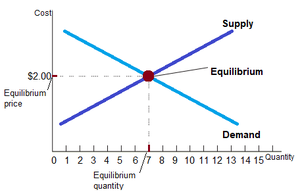Short run equilibrium
| Short run equilibrium |
|---|
| See also |
Equilibrium is a situation when the quantity supplied equals the quantity demanded at the current price. It is one of the three conditions that prevail in every market. At equilibrium, no tendency for price to change exists. Remaining are (Case K. E., Fair R. C., Oster S. M., 2012, p. 66):
- excess demand - the quantity demanded exceeds the quantity supplied at the current price,
- excess supply - the quantity supplied exceeds the quantity demanded at the current price.
The quantity demanded is the amount of a good that buyers are willing and able to purchase. Law of demand is the claim that other things equal, the quantity demanded of a good falls when the price of the good rises (Mankiw N. G., 2009, p. 67).
The quantity supplied of any good or service is the amount that sellers are willing and able to sell. The law of supply is the claim that other things equal, the quantity supplied of a good rises when the price of the good rises (Mankiw N. G., 2009, p. 73).
According to the Dictionary of economics, equilibrium is a state of balance such that a set of selected interrelated variables has no inherent tendency to change. Equilibrium can exist for an economy as a whole, for a sector of it, for a particular market or for an institution, such as a firm. The Marshallian and Keynesian cross diagrams are the most famous schematic representations of equilibrium (Rutherford D., 2002).
Example
Based on the example presented in Chapter 4 of the Microeconomics Principles, it can be determined the relationship between price and quantity supplied (Mankiw N. G., 2009, p. 67, p. 73, p. 77):
- There are many determinants of quantity supplied, but price plays a special role. When the price of ice cream is high, selling them is financially rewarding, and so the quantity supplied is large. Sellers of ice cream work long hours, hire a lot of workers and also buy many ice-cream machines. Sellers produce less ice cream when the price of ice cream is low because the business is less profitable. At a low price, some sellers may even choose to shut down, and their quantity supplied falls to zero. The law of supply applies here: other things equal, when the price of good rises, the quantity supplied of the good also rises, and when the price falls, the quantity supplied falls as well.
- The example shows how many ice-cream cones Catherine buys each month at different prices of ice cream. If ice cream is free, Catherine eats 12 cones per month. At $0.50 per cone, Catherine buys 10 cones each month. At $1.00 she purchases 8, at $1.50 - 6, at $2.00 - 4, at $2.50 - 2. As the price rises further, she buys fewer and fewer cones. When the price reaches $3.00, she doesn't buy any ice cream at all. This shows the relationship between the price of a good and the quantity demanded, holding constant everything else that influences how much consumers of the good want to buy.
- The quantity of ice-cream cones supplied each month by Ben, an ice-cream seller, at various prices of ice cream. At a price below $1.00, Ben does not supply any ice cream at all. At a price of $1.00 he supplies 1 cone, at $1.50 - 2, at $2.00 - 3, at $ 2.50 - 4 and finally at $3.00 he supplies 5 cones. The supply curve slopes upward because, other things equal, a higher price means a greater quantity supplied.
- The point at which the supply and demand curves intersect is called the market's equilibrium. The price at this overcut is called the equilibrium price, and the quantity is called the equilibrium quantity.
Here the equilibrium price is $2.00 per cone, and the equilibrium quantity is 7 ice cream cones.
References
- Buiter W. H. (2014), Temporary Equilibrium and Long-Run Equilibrium (Routledge Revivals), Routledge
- Case K. E., Fair R. C., Oster S. M. (2012), Principles of Macroeconomics, Pearson Education
- Horsley A., Wrobel A. J. (2016), The Short-Run Approach to Long-Run Equilibrium in Competitive Markets: A General Theory with Application to Peak-Load Pricing with Storage, Springer
- Mankiw N. G. (2009), Principles of Microeconomics, Cengage Learning
- Michl T. R. (2015), Macroeconomic Theory: A Short Course: A Short Course, Routledge
- Rutherford D. (2002), Routledge Dictionary of Economics, Taylor & Francis Group
Author: Natalia Supernak
